
Huntsman spiders, members of the family Sparassidae, are known by this name because of their speed and mode of hunting. They are also called giant crab spiders because of their size and appearance. Larger species sometimes are referred to as wood spiders, because of their preference for woody places. In southern Africa the genus Palystes are known as rain spiders or lizard-eating spiders. Commonly, they are confused with baboon spiders from the Mygalomorphae infraorder, which are not closely related.

Cyclosa conica is a small spider with no common name. It is an orb weaver, and it is easily recognized by the way it strings together the dead bodies of insects and other debris and hangs it near the center of its web. It hides on this string of debris, and its natural coloration makes it extremely difficult to see until it moves. One of its defenses against predators is to blend in with this debris and to feign death when disturbed. These spiders are small; the females range from 5.3 mm to 7.5 mm, and the males range from 3.6 mm to 4 mm.

The Pholcidae are a family of araneomorph spiders. The family contains more than 1,800 individual species of pholcids, including those commonly known as cellar spider, daddy long-legs spider, carpenter spider, daddy long-legger, vibrating spider, gyrating spider, long daddy, and skull spider. The family, first described by Carl Ludwig Koch in 1850, is divided into 94 genera.

Velvet spiders are a small group of spiders almost entirely limited to the Old World, with exception of a few species known from Brazil. In Europe some are commonly called the ladybird spiders
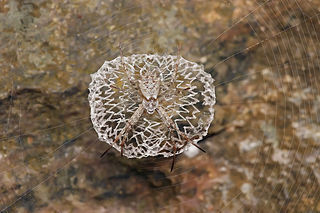
A stabilimentum, also known as a web decoration, is a conspicuous silk structure included in the webs of some species of orb-web spider. Its function is a subject of debate.
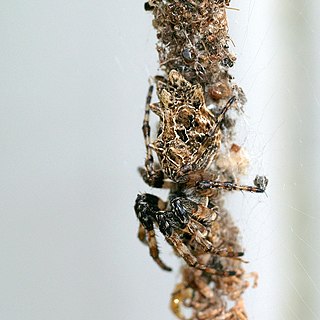
Cyclosa, also called trashline orbweavers, is a genus of orb-weaver spiders first described by Anton Menge in 1866. Widely distributed worldwide, spiders of the genus Cyclosa build relatively small orb webs with a web decoration. The web decoration in Cyclosa spiders is often linear and includes prey remains and other debris, which probably serve to camouflage the spider. The name "Cyclosa" comes from Greek 'to move in a circle', referring to how it spins its web.

Ballooning, sometimes called kiting, is a process by which spiders, and some other small invertebrates, move through the air by releasing one or more gossamer threads to catch the wind, causing them to become airborne at the mercy of air currents and electric fields. A 2018 study concluded that electric fields provide enough force to lift spiders in the air, and possibly elicit ballooning behavior. This is primarily used by spiderlings to disperse; however, larger individuals have been observed doing so as well. The spider climbs to a high point and takes a stance with its abdomen to the sky, releasing fine silk threads from its spinneret until it becomes aloft. Journeys achieved vary from a few metres to hundreds of kilometres. Even atmospheric samples collected from balloons at five kilometres altitude and ships mid-ocean have reported spider landings. Ballooning can be dangerous.

Acacesia is a genus of orb-weaver spiders first described by Eugène Simon in 1895. It contains six species with a mostly neotropical distribution, ranging from South America to Mexico. One species, A. hamata, is found in the US as well.

Aglais is a Holarctic genus of brush-footed butterflies, containing the tortoiseshells. This genus is sometimes indicated as a subgenus of Nymphalis or simply being an unnecessary division from the genus Nymphalis, which also includes tortoiseshells, but it is usually considered to be separate. This proposed separate genus is also considered "brushfooted butterflies" historically together with the other or separate Nymphalis species.

Cyclosa sierrae is an orb-weaver spider species found in Europe to Georgia.

Cyclosa argenteoalba, in the trashline orbweavers genus, is a species of orb weaver in the spider family Araneidae. It is found in East Asia in the countries of China, Japan, and Korea. C. argenteoalba are diurnal, which means they are active during the day. Each individual has a unique appearance due to their differences in the ratio of black to silver coloring on their abdomen. Spiders with less silver coloring are better at catching prey, since the silver is bright and warns their prey. They catch their prey by waiting in the hub of their web until their prey is close enough to catch. Parasitic larvae are often found attached to C. argenteoalba, and the larvae are able to manipulate the spider's behavior. Females are on average 2 mm longer in size than males. During mating, female genital mutilation is common in order to increase the fitness of the male. On their webs, they often attach silk “decorations” that are thought to deter predators. Relocating to a different place to build a new web occurs frequently until they find a location with a significant amount of prey.
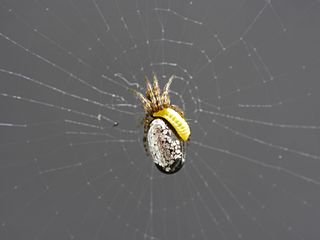
Reclinervellus nielseni is one of the spider-ectoparasitoids belonging to the Polysphincta genus-group and utilizes exclusively Cyclosa spiders as hosts. The species is distributed from Britain to Japan but is rather sparse. Host spider species is different in accordance with the region, that is Cyclosa conica in Europe whereas Cyclosa argenteoalba in Japan.
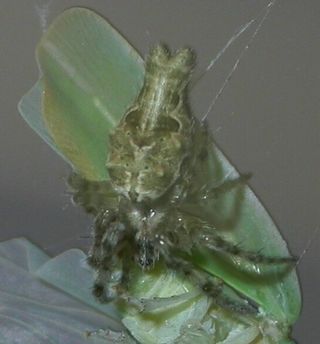
Allocyclosa is a genus of orb weaver spiders that contains only one species, Allocyclosa bifurca. It was first described in 1887 by McCook under the name Cyrtophora bifurca, and was transferred to its own genus in 1999. It is the only Cyclosa species north of Mexico to have a forked tail, hence the name bifurca, Latin for "two-forked". The forked abdomen, bearing two humps shaped like the letter M, is a defining feature in both males and females, though it is similar to features present in certain Cyrtophora species. Both sexes are a transparent green color, though only females have an area of red on their underside between the epigynum and the spinnerets. Females are nearly thirty percent larger than males, ranging from five to nine millimeters, while males range from two to three millimeters. Males are very uncommon. In a 1977 study by Levi, only two of the nearly 350 specimens that were positively identified as Cyrtophora bifurca were males. This is a very odd distribution, and it has been posed that females of the species, which have less prominent genitalia relative to other members of the orb-weaver family, may be parthenogenic, or able to reproduce without the help of males. Like other members of Araneidae, these spiders create orb webs, six to eight inches in diameter, but apply a unique form of protective mimicry. Females sit in the middle of a vertical row of web decoration, with egg sacs above and wrapped prey below. Because they all have a similar color and shape, it is difficult to discern between the egg sacs, the wrapped prey, and the spider itself.
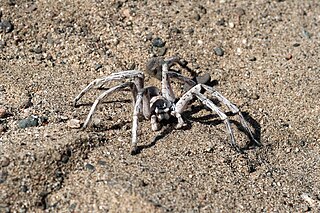
Orchestrella is a genus of Namibian huntsman spiders that was first described by R. F. Lawrence in 1965. As of September 2019 it contains two species, found in Namibia: O. caroli and O. longipes.

Hibana gracilis, the garden ghost spider, is a species of ghost spider in the family Anyphaenidae. It is found in the United States and Canada.

Cyclosa turbinata is a species of orb weaver belonging to the family of spiders known as Araneidae. It is found in a range from the United States to Panama, West Indies, Galapagos Islands, and has been introduced into Hawaii.

Cyclosa walckenaeri is a species of orb weaver in the spider family Araneidae. It is found in a range from the United States to Guyana and the Caribbean Sea.

Salsa is an Australasian genus of orb-weaver spiders.


















